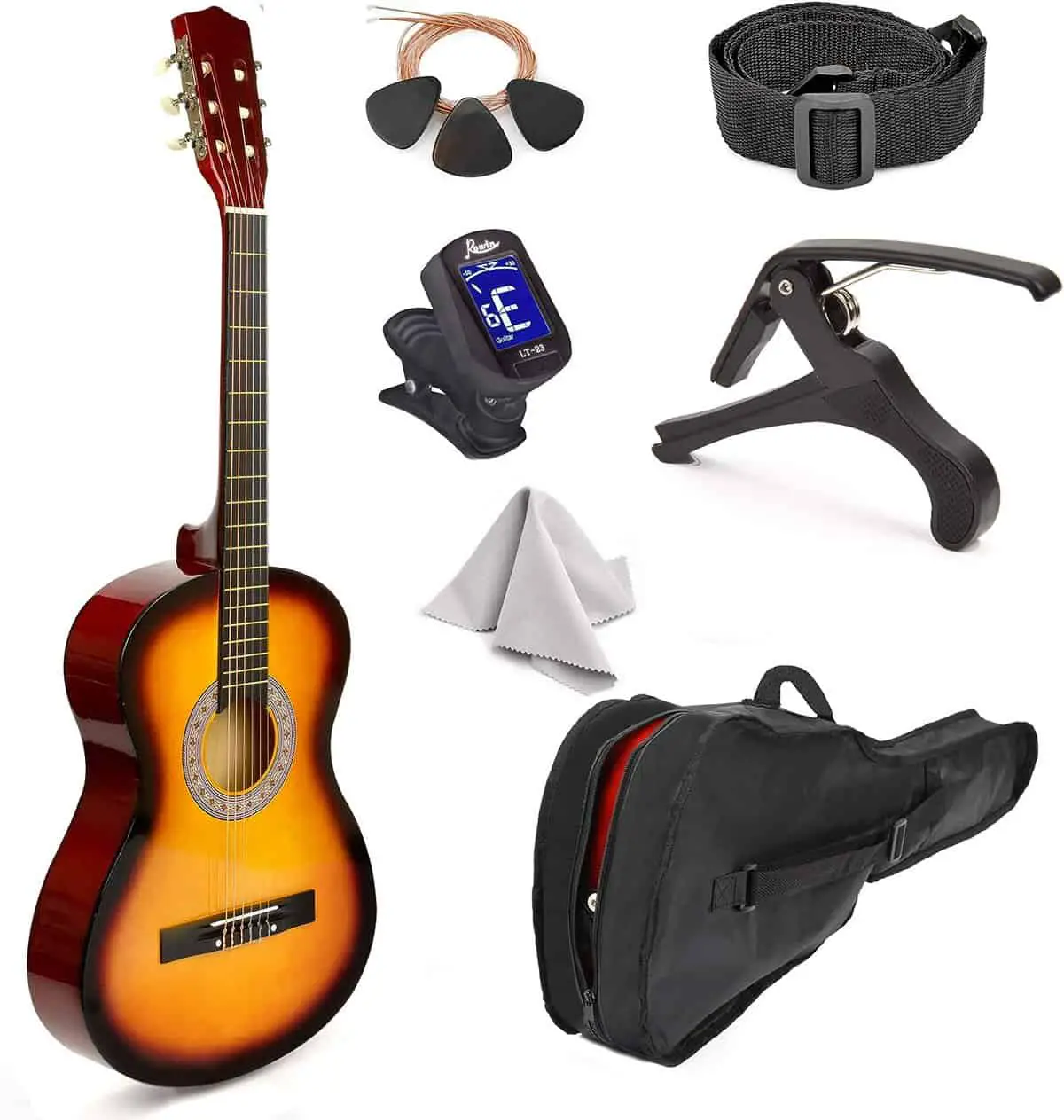Have you ever found yourself strumming a standard guitar and thinking, “This is great, but I wish it was just a smidge more manageable?”
Or perhaps you are in the market for a new guitar and want to know the best size to begin your musical journey.
If this sounds like you, then you’re in the right place.
This article dances around the captivating world of 38-inch guitars, focusing particularly on the question: Are they a good fit for adults?
Regardless of if you are an experienced guitar nerd or a beginner musician looking for your first guitar, you’ve probably come across many types of guitars in your research.
Full-size, half-size, acoustic, electric, classical guitars – the list goes on. Each comes with its unique persona, just like musicians themselves.
Among this diverse crowd, this musical instrument is like that laid-back friend who’s always fun to hang out with – not too demanding, yet surprisingly impressive.
We’ll unravel what it means to be a 38-inch guitar, demystify the terminologies, and explore the nooks and crannies of guitar sizes.
Most importantly, we’ll scrutinize whether a 38-inch guitar is a suitable companion for an adult, both for beginners taking their first steps into the music scene and seasoned pros seeking a different flavor in their musical journey.
We will also take a look into full-sized guitars and how they differ from the 38-inch guitar sizes. Full size guitars are often the go to for adults but there are so many great advantages
So, grab a cup of your favorite beverage, get cozy, and let’s embark on this melodic adventure together. Let’s hit the right notes and uncover the charming secrets of 38-inch guitars.
Understanding Acoustic Guitar Sizes
When we talk about acoustic guitars, we’re stepping into a territory that’s pretty well charted, yet filled with delightful surprises.
While at first glance, it might seem as straightforward as strumming a C major, there’s a symphony of details that can change the tune entirely. One such detail? Size.
Before we plunge into the realm of 38-inch guitars, let’s start with the basics and clarify what we mean when we say “size.” There are two key measurements in the limelight here:
Scale Length:
This is the length of the string that vibrates when you pluck it. To be precise, it’s the distance from the nut (right where the headstock ends and the neck begins) to the saddle on the bridge. Yet, luthiers, those maestros of guitar-making, often define it as twice the length from the nut to the 12th fret.
Entire Length:
This is the total length of the guitar, measured from the top of the headstock to the bottom of the body. It’s like taking a measuring tape to your guitar as if it were a supermodel.
Standard full-size acoustic guitars usually have scale lengths between 24 to 25.5 inches, similar to their electric counterparts. But when we say ‘guitar size,’ we could also be referring to the guitar body’s dimensions and shapes. That’s a whole different ballad.
So, where does a 38-inch guitar fit in this picture? A standard full-size acoustic guitar measures anywhere between 36 to 42 inches.
We also see guitars tagged as ¼, ½, and ¾ sizes. Now, these aren’t precise measurements. A ¾ guitar is usually just slightly smaller than a full-size one, say, about 7/8th of the size. That’s a game of inches that can drastically change the sound and feel of your six-stringed friend.
So, let’s tune in to the next section and focus on the star of the show: the 38-inch guitar.
What Are 38-Inch Guitars?
In the guitar realm, the term “38-inch” may sound like a secret chord that only a few have mastered. But let’s take the mystery out of it. A 38-inch guitar is simply a guitar that is 38 inches long. That’s it! No secret music society, no hidden luthier tradition.
38 inches falls right within the standard full-size guitar range, but it’s also at the shorter end. However, there’s a small quirk that we need to address. When a guitar is marketed as a “38-inch guitar,” more often than not, you’re dealing with a budget or beginner-friendly guitar from a less-known brand.
Imagine this: you’re scrolling through a digital music store, and you stumble upon a listing that mentions “38-inch guitar” rather than a specific model name.
Chances are, it’s a beginner guitar. Sure, these guitars are wallet-friendly, and their size makes them accessible for newcomers. Yet, their build quality and sound may not always hit the high notes.
But hold on, don’t dismiss all 38-inch guitars as mere beginners’ toys. Many well-crafted guitars fall into this size category, even though they might not be advertised as such.
It’s just when they’re specifically labeled as “38-inch guitars” that you might want to tune your expectations accordingly.
So, if a 38-inch guitar is good for beginners, does that mean it suits adult players too? Let’s dive into the next section to answer this burning question.
What Are 38-Inch Guitars Good For?
We’ve reached the heart of the matter – are 38-inch guitars suitable for adults, and what are they really good for? Answering this question isn’t as simple as strumming a G-chord, mainly because it’s quite broad. After all, 38-inch guitars come in a range of flavors, just like any other category of guitars.
But let’s hone in on the guitars that are specifically marketed as “38-inch.” Well, to be candid, they are primarily entry-level guitars, a first step into the vast world of music.
They are like the basic vocabulary you learn when picking up a new language. It’s essential, but it doesn’t quite capture the nuances and beauty of the language as a whole.
These guitars are reasonably cheap, and that makes them a viable choice for beginners who are just dipping their toes into the melodious waters of guitar playing.
They’re not the best, but they’re also not the worst. Think of them as a stepping stone towards your future guitar conquests.
Consider this analogy: a 38-inch guitar is like a runabout car. It’s small, easy to handle, and it gets you from point A to point B. But you wouldn’t want to take it on a cross-country road trip, would you?
That’s why, if you’re an adult beginner, these guitars can be a pretty decent choice. Their size makes them easy to handle, and you can learn the basics on them without feeling overwhelmed. But, remember, once you start picking up speed and your skills grow, you might want to consider upgrading to a better, more refined model.
But what about music styles? Can a 38-inch guitar strum out a blues riff as well as it handles a pop melody? Let’s find out in our next section.
Music Styles Suitable for 38-Inch Guitars
Guitars, irrespective of their size, are versatile beasts. With the right technique, you can coax all sorts of sounds from them, from the smooth strums of folk to the edgy riffs of rock. So, what about our 38-inch compadres? Can they play all the tunes you desire?
In essence, 38-inch guitars are musical chameleons. They can adapt to a variety of styles, but, like every instrument, they have their sweet spots. Their compact size and ease of playability make them excellent for acoustic styles, especially for strumming out those catchy pop tunes or a soulful folk melody.
Because of their slightly smaller scale length, beginners might find it easier to get to grips with chord changes, making these guitars great for rhythm playing. They might not have the deep resonance of larger guitars, but they hold their own when it comes to clean, clear tones.
However, if you’re looking to dive into more complex styles, such as jazz or intricate fingerstyle playing, you might find that a 38-inch guitar doesn’t quite hit the mark.
The limited fret space can be a constraint when it comes to exploring the upper registers or performing intricate solos.
But don’t let this deter you! Remember, every guitar has its own voice and purpose. And for a beginner, a 38-inch guitar is like a friendly tutor, helping you lay down the basics before you start jamming out to those more complex styles.
In our next section, we’ll see how 38-inch guitars fare in the market and discuss some options you can consider as a beginner.
38-Inch Guitars in the Market: Options for Beginners
It’s a big, wide world out there in the guitar market. From majestic dreadnoughts to nifty parlor guitars, the sheer variety can leave you in a spin.
As for 38-inch guitars, they often fall into a specific niche: affordable, easy-to-play instruments for beginners. Let’s dive into this segment and uncover some options.
One of the most common types of 38-inch guitars you’ll find is the classical guitar. With nylon strings and a smaller body, they’re gentle on the fingertips and easier to handle, especially for beginners.
Brands like Yamaha, Cordoba, and Stagg have some solid options in this category, offering a great blend of playability, tone, and affordability.
If steel strings and the bright, lively tones of folk and pop are more your jam, fear not! The market is ripe with 38-inch acoustic guitars that will deliver the goods without leaving a hole in your pocket. Brands like Donner and Jasmine have beginner-friendly guitars that deliver a surprising amount of bang for the buck.
Finally, if you’re on the lookout for a versatile 38-inch electric guitar, Squier by Fender has you covered. Their Mini Strat electric guitars are known for their punchy tone and smooth playability, making them a great choice for budding rockstars.
But remember, folks, the key is to play before you pay. Try out the guitars, listen to their tone, feel their action, and let your fingers do the deciding.
At the end of the day, the best guitar for you is the one that inspires you to play, practice, and unleash your inner music maestro. Stick around, as in the next section, we’ll share some tips on avoiding misleading marketing tactics while shopping for your first 38-inch guitar.
Is a 38 inch guitar the same thing as a full size guitar
An acoustic guitar size of 38 inches is not considered a full-sized guitar. Full-sized guitars, typically referred to as concert guitars or dreadnoughts (steel string acoustic), are usually about 40 to 42 inches in length.
The number, 38 inches, refers to the total length of the guitar from the top of the headstock to the bottom of the body. This makes a 38-inch guitar smaller than a full-sized instrument, often comparable to a 3/4 size guitar.
While it’s smaller than a full-sized guitar, a 38-inch guitar can be an excellent choice for younger players, beginners, or individuals with smaller frames, as its size can make it easier to handle and play. However, its tone and volume might not be as robust as a full-sized instrument.
Regardless, both musical instruments share the same basic strumming patterns and either way you can get great sound from each guitar’s tone.
What’s Better, a 38 Or 41 Inch Guitar For Beginners?
For beginners, a 38-inch guitar can be an excellent choice because of its manageable size and ease of play. However, a 41-inch guitar offers a fuller sound and may be more suitable if size and reach are not issues for the player.
What Guitar Strings are common on a 38 inch guitar
A 38-inch guitar typically falls in the category of smaller guitars, similar to a 3/4 size guitar. These guitars often come with lighter gauge strings to facilitate easier playability, especially for beginners or those with smaller hands.
The most common type of strings for these guitars are light or extra-light acoustic guitar strings. Here are the typical gauges:
- Light: .012 .016 .025 .032 .042 .054
- Extra Light: .010 .014 .023 .030 .039 .047
Remember, the choice of guitar strings can significantly affect the sound and playability of the guitar. Lighter strings are easier to press down and bend, but they produce a thinner, less resonant sound than heavier strings.
On the other hand, heavier strings can be harder to play but can produce a fuller, richer sound. Therefore, it’s essential to balance comfort and sound quality based on individual preference when choosing guitar strings.
Avoiding Misleading Marketing Traps
We live in an era where information is everywhere, but truth be told, not all of it is helpful. In fact, when hunting for the perfect 38-inch guitar, you might encounter some marketing tactics that are more smoke and mirrors than helpful facts. But fear not! We’re here to help you navigate these murky waters.
One common ploy is advertising an instrument simply by its size, like “38-inch guitar.” If that’s the main selling point, then caution is advised. Often, these are basic beginner guitars from no-name brands, crafted more for mass production than music production.
They might be cheap, and perhaps even visually appealing, but their quality and playability are often a far cry from what a beginner needs.
Now, don’t get us wrong, not every affordable or beginner instrument is a dud. But remember, a good guitar is more than just a size specification. Look for information about the type of wood used (called the tonewood), the type of strings, the quality of the hardware, and, if possible, listen to a sound sample.
Another red flag is vague or general descriptions that don’t give you any meaningful insights into the instrument. If the product description spends more time boasting about the guitar’s colorful design rather than its sound quality or playability, it’s best to proceed with caution.
That said, beginners on a tight budget shouldn’t be discouraged. There are plenty of good quality, affordable guitars out there that are perfect for learning. In the next section, we’ll round off our discussion and share some parting thoughts on 38-inch guitars for adults. Stay tuned, folks!
Our Recommended Choice for Beginner Guitarists
The package below is a suitable choice for beginners looking to feel out the guitar without the commitment of a pricey full-sized name-brand guitar. This setup will give you everything you need in one place.
38-Inch Guitars: Wrapping It Up
Ah, the grand finale! By now, you should have a comprehensive understanding of 38-inch guitars, the nuances that separate them from their full-sized counterparts, and the potential pitfalls in picking one out from a crowd. We’ve strummed the key points and hit all the important notes, but let’s recap just to make sure it all sticks.
First and foremost, remember that a 38-inch guitar is, in essence, just a guitar. It’s got strings, frets, and a hole in the middle just like any other. The ’38-inch’ part is simply a measure of its length, placing it within the average size range for guitars. However, this alone doesn’t determine its quality or suitability for adults.
When considering a 38-inch guitar, think about its playability and comfort, not just its size. Many adult beginners, especially those with smaller hands, find the 38-inch size more manageable than larger guitars, making it a good choice for getting started.
However, caution is key when shopping for these guitars, especially online. Often, guitars advertised primarily by their size are low-end, beginner instruments that may not deliver the sound quality or durability you need. Always look for additional information about the guitar’s materials, construction, and brand reputation.
If you’re a beginner on a budget, don’t be disheartened by the idea of dodging duds. There are plenty of affordable 38-inch guitars that can deliver a fantastic learning experience. Just be patient, do your research, and remember: every great guitarist started somewhere!
Whether you’re a newbie guitarist or an experienced strummer curious about 38-inch guitars, we hope this article has struck a chord with you. Happy playing, and remember, music is a journey, not a destination. Enjoy every note along the way!



![Best MIDI Keyboards [2023 Review]](https://instrumentful.com/wp-content/uploads/2023/06/midi-keyboards-cover-image-440x264.jpg)



